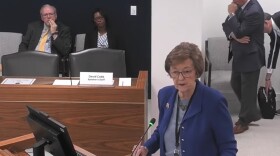The UNC System Board of Governors is debating policies that would dramatically change how North Carolina’s public universities are funded.
Under the administration of President Peter Hans, the UNC System is preparing to move to a performance-based model for funding its universities. The board of governors approved the use of the new model in April, and is now hashing out the details for how a university’s performance will be weighted.
Historically, the 16 public universities have been allotted state funding based primarily on their total enrollment. That has put pressure on universities to continually grow their student bodies.

The issue is enrollment is falling across the UNC System, and across the country. While final fall enrollment counts for individual universities have not yet been released, overall UNC System enrollment fell by about 2% this school year — and that number could be much higher at some campuses.
The UNC System Board of Governors discussed two policy changes this week that system administrators say could help shield universities from the funding effects of declining demand.
Raising the cap on out-of-state students
Until recently, the out-of-state enrollment at all UNC System schools, except for the UNC School of the Arts, was capped at 18%.
That ensures that North Carolina residents first and foremost benefit from the public universities. Schools that repeatedly exceed the cap can be fined. UNC-Chapel Hill paid a $1 million fine in 2016.
Out-of-state tuition can cost up to five times more than in-state tuition, so an increase in out-of-state students could generate significant funding for some universities. Under the new funding model, out-of-state students are not supported by taxpayer funding.
In the past couple of years, the UNC System has raised the cap for its HBCUs. Now it's proposing to raise the limit on out-of-state undergraduates from 18% to 25% at five more universities: East Carolina University, UNC Asheville, UNC Greensboro, UNC Pembroke and Western Carolina.
“These institutions have had the largest declines in in-state freshman enrollment, and have largely exhausted in-state student demand,” said David English, a UNC System administrator.
If the policy passes, only Appalachian State, NC State, UNC Chapel Hill, UNC Charlotte and UNC Wilmington would be required to meet the lower 18% cap.
This is what the new cap structure would look like:
- 18% App State, NC State, UNC-CH, UNC-Charlotte, UNC-W
- 25% ECU, UNC-Asheville, UNC-G, UNC-P, WCU, FSU*, WSSU*
- 35% N.C. A&T* and NCCU*
- 50% ECSU*
*These universities are currently capped at this rate under policies passed in the prior two years.
“I think this is a smart thing to do. I think it's the right thing to do,” said UNC System President Peter Hans.
Hans says universities that have continued to have high demand from in-state applicants will remain at the original cap, while the schools being considered for the higher cap have declining demand from in-state students.
The chancellors from Western Carolina and UNC Pembroke said at the board meeting Wednesday that this policy change would increase their student demand because of their proximity to bordering states.
The board plans to vote on the out-of-state student policy in December at the earliest.
Performance-weighted model
The UNC System Board of Governors had planned to vote on final approval for the performance-weighted funding model this week, but tabled the vote until November due to lingering questions from members of the budget and finance committee.
“This is probably the most critical decision this board will make in a decade, because it has the impact of how the campuses operate for years into the future,” said NC State Chancellor Randy Woodson.
President Peter Hans has said the primary purpose of the new model is to incentivize universities to meet the UNC System’s strategic goals, but it could also alleviate the effect of falling enrollment on state funding.
Board of Governors Member Lee Roberts, a former state budget writer for Pat McCrory, explained at the Thursday board meeting that under the old funding model UNC System universities would lose a total of $62 million in state funding based on this year’s enrollment. Under the new model, they would lose $36 million, he said.
“That's $26 million, roughly a little bit more in incremental funding generated by the performance funding model, and shows that the model is doing what it was intended to do, which was minimize the whipsaw created by the old enrollment-driven model,” Roberts said.
He added: "I'd note that 13 schools do better under the performance funding model than under the old enrollment model, two schools do slightly worse."
UNC System officials have not yet released which universities would not benefit under the new model.

The new funding formula prioritizes graduating in-state students on time, and would reward or penalize universities for their overall four-year graduation rate and changes to student debt. These priorities align with the UNC System’s strategic goals.
UNC System CFO Jennifer Haygood showed the results of an analysis that found every university in the system would receive a positive weight in the new formula based on their “performance” in the 2021 school year.
However, it is unclear what the final output of that formula would be in terms of actual funding for each university.
“It's very complicated. You know, I've got a CFO that's been the CFO of three institutions in the [UNC] System, and he's struggling with this,” said NC State Chancellor Woodson.
Woodson called for clear examples of how the model would affect funding at individual universities. Others raised questions about how the formula’s focus on in-state students might play out, in light of a change to the out-of-state student cap.
The board's budget and finance committee chair Jim Holmes promised to share more data at the next meeting and bring examples of how the new model would affect universities.
Editor’s Note: An earlier version of this story incorrectly stated the cap on out-of-state freshmen at North Carolina Central University.







